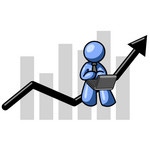With all the recent talk about tablets, mobile Internet devices and the cloud, you’d be forgiven for thinking that the
May 20, 2011

By Lenovo Guest Blog 2
 With all the recent talk about tablets, mobile Internet devices and the cloud, you’d be forgiven for thinking that the humble laptop was on its way out. But those who have been around the IT industry for a long time have heard such noises before. Speculators predicted desktop PCs would be obsolete years ago, but those old desktop boxes, and even those all-in-one models, are still with us today. Indeed, the latest market surveys show laptop growth continuing, although more slowly than years past. For example, market-research firm IDC predicts the global PC market to grow by 5.5 percent this year. Additionally, the firm set a 12.5 percent growth rate for PC sales between now and 2014.
With all the recent talk about tablets, mobile Internet devices and the cloud, you’d be forgiven for thinking that the humble laptop was on its way out. But those who have been around the IT industry for a long time have heard such noises before. Speculators predicted desktop PCs would be obsolete years ago, but those old desktop boxes, and even those all-in-one models, are still with us today. Indeed, the latest market surveys show laptop growth continuing, although more slowly than years past. For example, market-research firm IDC predicts the global PC market to grow by 5.5 percent this year. Additionally, the firm set a 12.5 percent growth rate for PC sales between now and 2014.
The simple fact is that tablets don’t cut it when it comes to content creation. You still need a computing tool that can “do things”—not just browse the web and play Angry Birds, but manage multiple applications, edit photos, cut and paste snippets of information, etc.; you get the idea.
Here They Come…

lenovo IdeaPad Y570
Lenovo IdeaPad Y570
So forgive us—perhaps unfashionably—for launching some new laptops. Yawn, yawn. Our new generation IdeaPad Y570 and Y470 are “performance multimedia” laptops with speedy new 2nd Gen Intel processors, brilliant High-Def screens and all the stuff you need for doing. These products then, are not earth-shattering news, I will admit. However, they do hint at future trends in “traditional” notebook PCs.
In my opinion, there are three ways for laptop manufacturers to respond to the onslaught of “mobile devices”:
Slash prices, but that’s not really sustainable since the cost of producing a laptop over the long term will be similar or even higher than a tablet.
Copy the key advantages of tablets—i.e. make laptops thinner, lighter and touch-enabled; perhaps a “tabbook”?
Focus on the advantages of laptops over tablets and make those advantages strong.
Outperform
Most manufacturers are likely to try all of the above, but Lenovo is focusing on the “third way” and the latest manifestation of that is our new Y Series, available today. Underneath the lid, there are some engineering differences that make these products work better than anything else you’ll find in the mainstream price segment. For the Y Series, it’s all about “performance multimedia.”

Lenovo-IdeaPad-Y470
Lenovo IdeaPad Y470
If you like to actually do things with your PCs, then you know performance is key. Many of us replace our old machines because they can’t handle multitasking applications—they just get hot and make a lot of noise. In our Y Series, we’ve gone further with our thermal engineering to ensure components can run at peak performance without overheating. Compared with previous models, the palm rests on the Y570/Y470 are about 4°C cooler than ambient air temperature. This lets us pack the best processor and graphics technologies inside and allows them to run as fast as possible. In fact, our Y470 can be configured with the highest-performance graphics available in a 14-inch laptop today.
Windows 7…Enhanced
Lovely Windows 7; it works pretty well, eh? With our Enhanced Experience 2.0 standard, Windows 7 works even better. “EE 2.0 PCs,” as we like to call them, start-up 20 seconds faster than a typical competitor Windows 7 PC. They also shutdown, sleep and resume quicker. Check out www.lenovo.com/ee2 for more info.
Those who literally can’t wait for their computer to start should probably pick the ultra-optimized IdeaPad Y570 with RapidDrive SSD technology. It’s the fastest-booting Windows 7 PC in production today with a stonking sub-10 second boot time. We demo’ed a similar PC—a ThinkPad—at CES back in January and saw it beat even a spec’d-up MacBook Air. Click here to watch the video.
Speed isn’t everything, though. We’ve also optimized our Y Series to improve multimedia capabilities. If you’ve ever listened to music or watched a video with the speaker volume turned way up on your old laptop, then you’ve probably experienced some audio limitations. The new Y Series has speaker chambers that are 10 cubic centimeters—twice that of a typical consumer laptop. Simple physics means that with a larger speaker, you’ll get better audio quality and less vibration. Our Y Series is one of the very few with JBL-certified speakers at less than $1,000.
This “third way” approach we’ve taken engineers our laptops to be even better at doing than ever before. Video, games, music, multitasking apps, photo editing, homework, etc.—the IdeaPad Y Series can handle it all and better than most. So, the next time you want to get hands-on and do something other than browse the Web, consider the fact that a good ole’ laptop might be a better tool for the task, and then remember “Y.”
Michael Littler is from Lenovo Product Group Marketing. Monthly guest blogs such as this one are part of The VAR Guy’s annual sponsorship program. Read all of Lenovo’s guest blogs here.
You May Also Like
